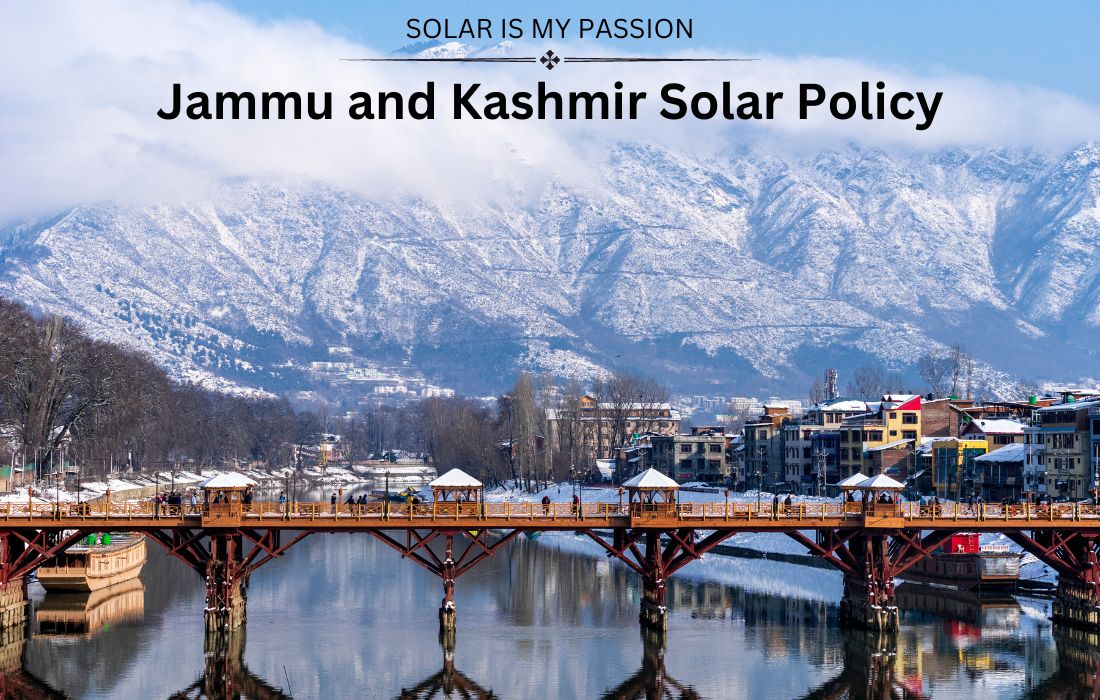1. INTRODUCTION
1.1 The challenges of climate change and global warming continuously threaten the world community. The Government of Jammu & Kashmir has taken note of the growing recognition of impact of climate change at the local, national and global levels. The Government recognizes the urgent need to tackle challenges that arise on account of these impacts through integrated policy prescriptions and programmes aimed at mitigation of impacts and adaptation to reduce vulnerability of systems. The Goverment is also cognizant of the cross-cutting nature of impacts with enormous cost implications for tackling them and that these costs could escalate if preventive action is not taken immediately. Besides this MNRE has launched Jawaharlal Nehru National Solar Mission (JNNSM) under the brand ‘Solar India’ with the objective to establish India as a global leader in solar energy, by creating the policy conditions for its diffusion across the country as quickly as possible. The Mission has set a target of 20,000MWand stipulates implementation and achievement of the target in 3 phases (first phase up to 2012-13, second phase from 2013 to 2017 and the third phase from 2017 to 2022) for various components, including grid connected solar power.
1.2 The successful implementation of the JNNSM requires the identification of resources to overcome the financial, investment, technology, institutional and other related barriers which confront solar power development in India. The penetration of solar power, therefore, requires substantial support. The policy framework of the Mission will facilitate the process of achieving grid parity by 2022.
1.3 To ramp up capacity of grid-connected solar power generation to 1000 MW within three years by 2013; an additional 3000 MW by 2017 through the mandatory use of the renewable purchase obligation by utilities backed with a preferential tariff. This capacity can be more than doubled reaching 10,000MW installed power by 2017 and 20,000 MW or more by 2022 in the country. The transition could be appropriately up scaled, based on availability of international finance and technology
2 Needs for Solar Power Projects
2.1 Solar energy is environmentally friendly as it has zero emissions while generating electricity or heat. The exhaustible reserves of fossil fuels and their volatile market prices further contribute towards energy insecurity Government recognizes the central role of energy and the need to have the policy to promote efficient use of conventional energy together with proactive establishment and promotion of sustained use of new and non-conventional energy sources and applications to reduce emissions and other impacts of climate change Based on this “climate efficient initiative” the state has decided to promote energy efficiency measures, adopt preventive management techniques and build capacities for all the concemed stakeholders to contribute and sustain successful transitions to a more energy efficient future duly emphasizing the local relevance of alternatives
2.2 From an energy security perspective, solar is the most secure of all sources, since it is abundantly available. Theoretically, a small fraction of the total incident solar energy (if captured effectively) can meet the entire country’s power requirements. It is also clear that given the large proportion of poor and energy un-served population in the country, every effort needs to be made to exploit the relatively abundant sources of energy available to the country. While, today, domestic coal based power generation is the cheapest electricity source, future scenarios suggest that this could well change. Already, faced with: crippling electricity shortages, price of electricity traded internally, touched Rs 7 per unit for base loads and around Rs 8.50 per unit during peak periods. The situation will also change, as the country moves towards imported coal to meet its energy demand. The price of power will have to factor in the availability of coal in international markets and the cost of developing import infrastructure. It is also evident that as the cost of environmental degradation is factored into the mining of coal, as it must, the price of this raw material will increase. In the situation of energy shortages, the country is increasing the use of diesel-based electricity, which is both expensive – costs as high as Rs 15 per unit – and polluting It is in this situation the solar imperative is both urgent and feasible to enable the country to meet long-term energy needs.
3. OPERATIVE PERIOD
3.1 The Policy will come into operation with effect from its publication in the State. Gazette and will remain in force until super ceded or modified by another Policy
4. CAPACITY CAP
4.1 The minimum project capacity shall be 1 MW However, if MNRE launches any scheme for lower capacity power plant then that shall also be considered
5. ELIGIBLE UNIT
5.1 Any company or body corporate or association or body of individuals or project proponents as per MNRE Schemes/ guidelines launched/issued from time to time will be eligible for setting up of Solar Power Plants (SPPs), for the purpose of captive use and/or for sale of electricity as per J&KSERC/ CERC regulations
Objectives of Jammu & Kashmir Solar Policy
The State Government introduces this Policy with the following objectives:
3.1 To contribute to solar capacity addition and fulfillment of Solar targets set by the Ministry.
3.2 To optimally utilize the available solar energy resource in the State.
3.3 To encourage the development and promotion of environment-friendly solar energy generation contributing to sustainable development.
3.4 To enable stakeholders in reducing greenhouse gas emissions.
3.5 To attract private sector participation in solar energy sector.
3.6 To build a favorable environment for setting up Grid Connected Rooftop Solar Photovoltaic Power Plants.
3.7 To enhance skills and create employment opportunities.
3.8 To contribute to productive utilization of available rooftop spaces.
3.9 To spread environmental awareness amongst the general public of J&K.
DISCOM Links are Below:



Sir I want one solar system for home urgent
Contact your nearest delaer